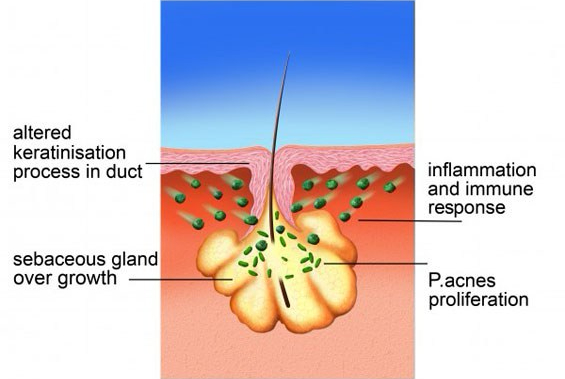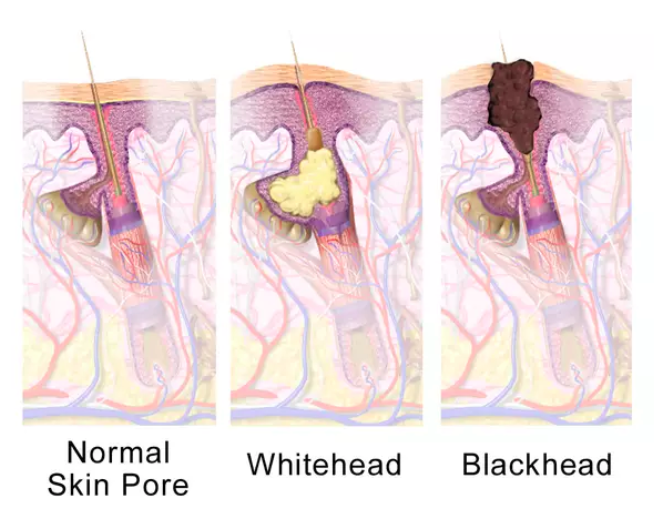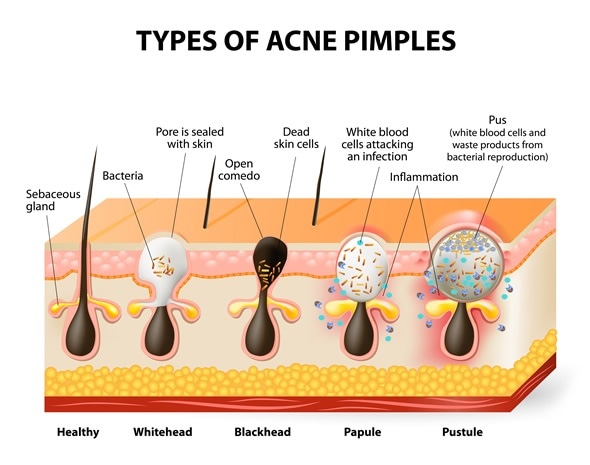Everyone’s mutual enemy takes centre stage once in a while (if you’re lucky), or becomes your clingy soulmate for life. Either way, no one likes it around. So what do you do? Well, first, get to know what it is and what’s causing it, then identify proper ways to eliminate it without affecting future ones surfacing.
What is Acne?
Remember about those sebaceous glands I mentioned here? No? Okay recap: these glands are in-charge of secreting an oily substance called sebum. Acne is basically when those glands become inflamed. How? People with acne are usually those with oilier skin types. So having oilier skin means you’d need a larger sebaceous gland, which helps with producing more sebum. When your sebaceous glands are over grown, this allows bacteria (known as Propionibacterium acnes, or just P. acnes) and skin cells to be trapped in there, which then would lead to an inflammation.

Types of Acne
Pimples (pustules), papules, black/whiteheads and nodules are all types of acne. They are all bacterial attack on your skin, but they all look and are to be treated differently to one another. Let’s get to know them better, shall we?
Blackheads and whiteheads are commonly around the facial area, though they can also be found around your body. They are considered to be a mild form of acne and barely cause any pain. When the p. acnes bacteria does not infect the sebaceous glands, all the dead skin cells + sebum surface to skin level. It then creates a bump called a comedo. If the bump remains closed and hidden, it creates a whitehead. If the bump is outwards and exposed, it oxidises and becomes darker, creating a blackhead.

So how is the proper way of eliminating them? I know it’s tempting to just squeeze it out when you see a whole sea of them in the mirror, but wait! Extracting them without professional help can cause further damage. Removing them like this would, yes, remove the blackheads, but it would then leave your pores open and very inviting for dirt and bacteria to enter. Leaving on active ingredients like retinol or salicylic acid for a significant period of time will dissolve the dead skin cells without affecting the pores. This process will take much longer than just squeezing them out yourself but it will lead to a permanent elimination of blackheads & whiteheads. For more methods, read here.
 But when one usually refers to an acne, they’re really talking about pustules. These are the ones most commonly known as “pimples”, which are the less painful but more visible cousin of papules. Pustules are acne that are medium in size and have a yellow-ish, pus-filled centre surrounded by red inflammation, and they’re the most tempting to pop out of all acnes. Before you do it, have a think if this temporary relief really worth the dark scarring and bacterial infection? Probably not. Instead, apply disinfectants like apple cider vinegar (which not only has antibacterial properties, but also anti-inflammatory properties to soothe the redness!) on it. Topical acne treatment like tea tree oil solution applied on affected areas and even mixing some tea tree oil in your daily moisturiser helps prevent future breakouts. Other active ingredients to look out for include salicylic acid and niacinamide, both of which aid in controlling the overproduction of sebum and have anti-inflammatory properties.
But when one usually refers to an acne, they’re really talking about pustules. These are the ones most commonly known as “pimples”, which are the less painful but more visible cousin of papules. Pustules are acne that are medium in size and have a yellow-ish, pus-filled centre surrounded by red inflammation, and they’re the most tempting to pop out of all acnes. Before you do it, have a think if this temporary relief really worth the dark scarring and bacterial infection? Probably not. Instead, apply disinfectants like apple cider vinegar (which not only has antibacterial properties, but also anti-inflammatory properties to soothe the redness!) on it. Topical acne treatment like tea tree oil solution applied on affected areas and even mixing some tea tree oil in your daily moisturiser helps prevent future breakouts. Other active ingredients to look out for include salicylic acid and niacinamide, both of which aid in controlling the overproduction of sebum and have anti-inflammatory properties.
Read more about acne here: Exposed Skin Care, Vita Medica, Medical News Today
Pictured: The Ordinary Salicylic Acid 2% Solution (RM49), The Ordinary Niacinimide (RM60), The Body Shop Tea Tree Range (RM18-RM95), Origins Spot Remover with Salicylic Acid (RM80), Mario Badescu Drying Lotion (RM97)





